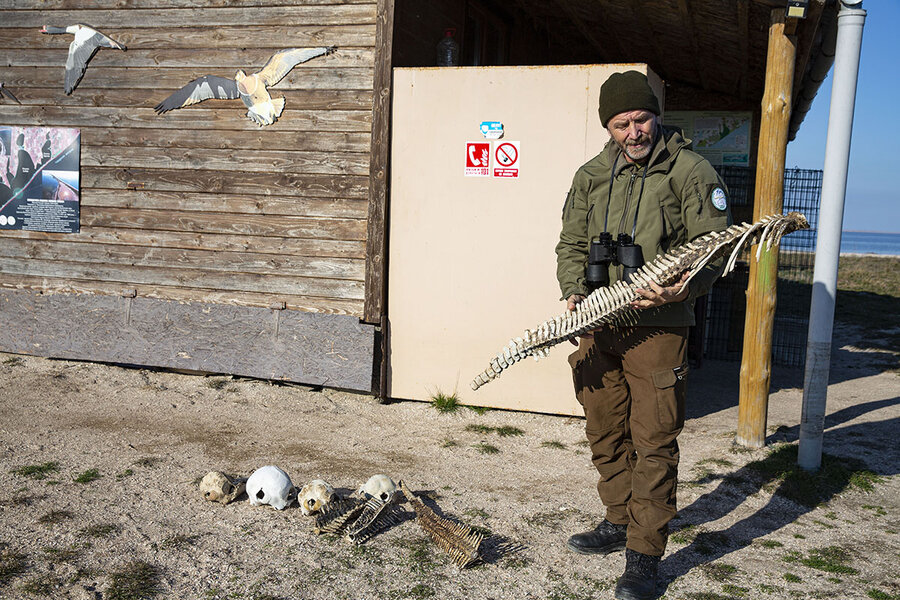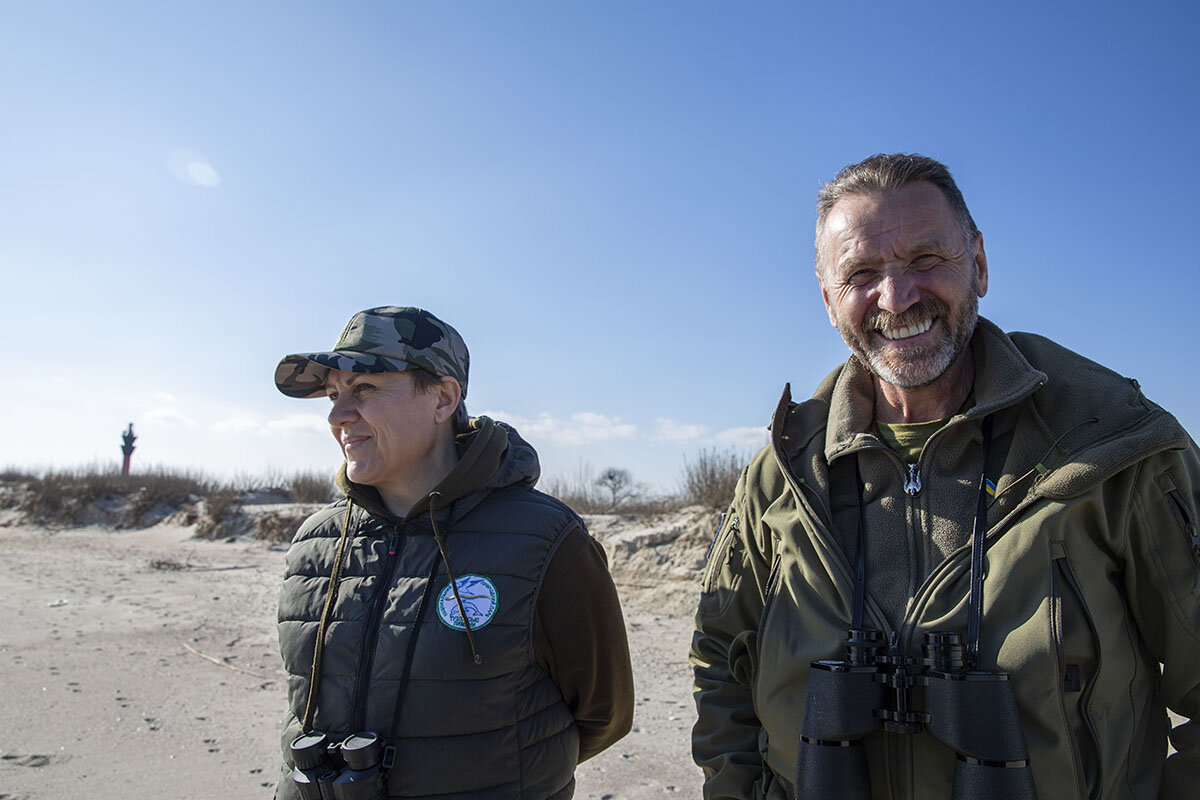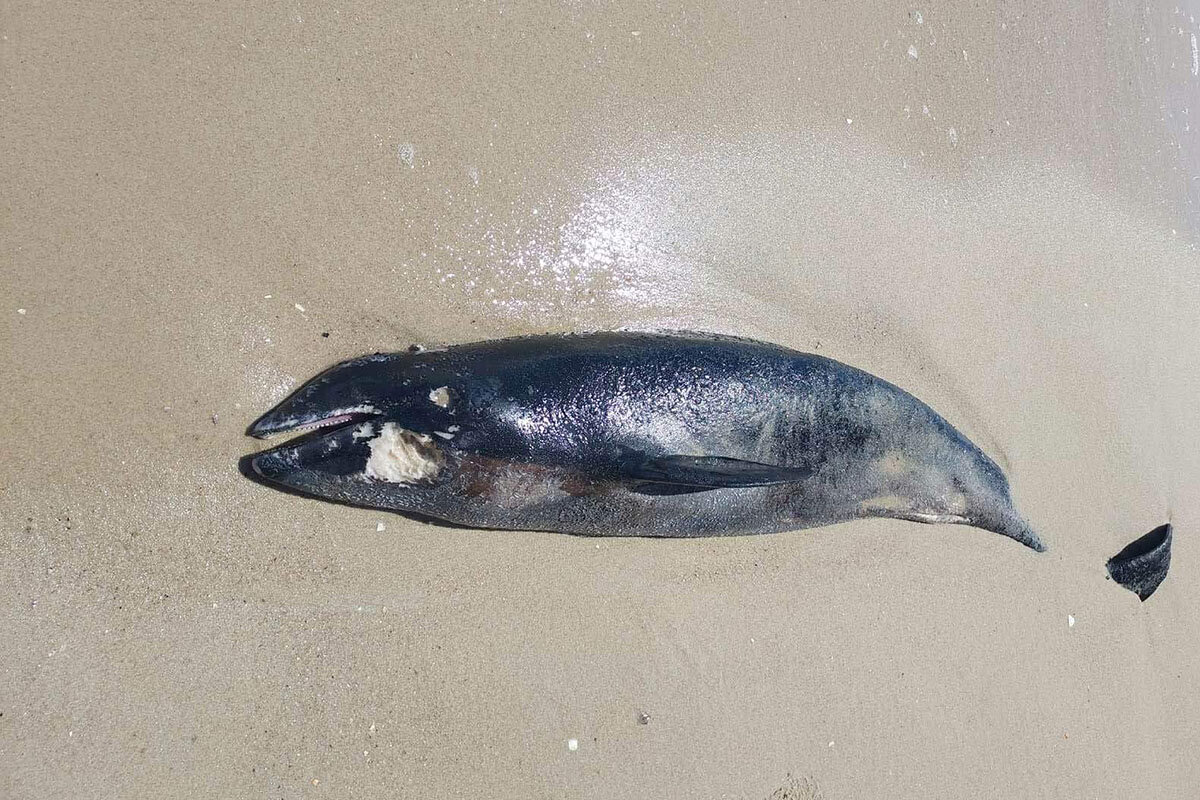Dolphins as casualties: The environmental costs of Ukraine war
Loading...
| Odesa, Ukraine
War has turned a pristine, white-sand beach near the Ukrainian Black Sea resort town of Odesa into a crime scene.
The victims? Dolphins. The alleged crime? Ecocide, commonly understood as intentional mass damage to the environment and wildlife. And Ukraine is determined to hold Russia accountable for it.
Last year saw a sharp rise in the number of unexplained dolphin deaths and strandings, says Ivan Rusev, a marine biologist with a passion for Black Sea dolphins. Behind him, on the wall around the beach hut that he uses as an office, sits macabre evidence of the slaughter – six skulls that once belonged to bottlenosed dolphins and porpoises.
Why We Wrote This
A story focused onUkrainian law defines ecocide – deliberate mass damage to the environment – as a crime. Prosecutors are drawing up a case against the Russian navy, blaming its Black Sea fleet for a sharp spike in dolphin deaths.
The Ukrainian authorities blame Russian military activity in the Black Sea for the unusual death rate among marine mammals. Russia has launched missile strikes on Ukrainian air defense batteries on the edge of the Black Sea Biosphere Reserve, and laid mines in coastal waters (as has the Ukrainian navy).
Russian naval vessels belonging to the Black Sea fleet, operating from the Crimean port of Sevastopol, also make constant use of acoustic sonar signals, which biologists say interfere with dolphins’ natural sonar that they use as an echolocation tool.
The combination of military sonar and bombardments mean that “it is as if the dolphins were left without eyes or ears,” says Dr. Rusev, the director of research at the Tuzly Lagoons National Nature Park, south of Odesa. “They have no chance to orient themselves. They become very thin. Their immune systems becomes weak. They may die for another reason, like an infection. But the first problem is the bombardment.”
“Dolphins blow themselves up on sea mines. Russian military ships use sonars that have had a huge impact on dolphin life,” adds Ruslan Strilets, Ukraine’s environment minister, in a video interview from Kyiv.
Also contributing to the dolphins’ fate is pollution, says Mikhail Son, a researcher at the Institute of Marine Biology in Odesa. Satellite images show a large number of oil slicks in protected areas. “About 30% to 40% of the Black Sea Biosphere Reserve is newly polluted” by war-related items such as missiles, a sunken Russian ship, fuel leaks, shells, and other toxic materials, he says.
Who is to blame?
It is not easy, Mr. Strilets acknowledges, to arrive at accurate estimates of how many dolphins have perished in the Black Sea since Russia invaded Ukraine in February 2022. But Dr. Rusev, who has spent years studying the creatures and their habitat, offers a telling statistic.
Before the war, he says, in a normal year, he would find about three dead dolphins stranded along a 28-mile stretch of beach. Since the Russian invasion, he has found 38 dolphin corpses in just the four-mile sliver of dune-fringed coastline that the Ukrainian military allows him to monitor.
At the special ecological crime office in Odesa, prosecutor Volodymyr Frantsevych says that the Ukrainian authorities have officially registered 117 dolphin deaths along the stretch of Black Sea coastline that their troops control, and that these deaths comprise the core of the ecocide case he is building against the Russian military.
They represent only a small fraction of the number of deaths experts believe to have occurred: The large majority of dolphins that die sink to the sea floor undetected. But the numbers are not the point, argues Kyiv-based zoologist Pavel Gol’din.
“If they really died due to military action by the Russian army, it doesn’t matter how many there were,” says Dr. Gol’din. “If I say 1,000 died, this is a terrible crime. If I say 100, that’s also a terrible crime. The number itself is not evidence of a cause or evidence of a crime.”
But, he adds, “if there is mass death of cetaceans, this can disrupt the whole ecosystem. The dolphins are invaluable.”
Dr. Gol’din performed autopsies on some of the dolphins stranded in Ukraine, and sent inner ear and cranial samples to laboratories at Italian and German universities for analysis. The results of their examinations, expected by year’s end, should help clarify the causes of the deaths.
For now, Dr. Gol’din stresses, multiple hypotheses are on the table. But he finds some recent live strandings intriguing. Typically, when a dolphin or a porpoise is stranded alive this means it is ill and likely to die within hours, he says. But this year, two of 16 dolphins stranded alive on Ukrainian beaches recovered and returned to the sea. “This is highly unusual,” Dr. Gol’din says. “This may be indirect evidence of [temporary] blast injury.”
Odesa prosecutor Mr. Frantsevych invoked Article 441 of Ukraine’s criminal code, which defines ecocide as a crime, last July and says he is gathering evidence against specific Russian naval vessels and even their crews.
“We have information from Ukrainian naval intelligence units about the routes of the Russian Black Sea fleet during the period that those dolphins were found,” says Mr. Frantsevych. “We also have information about the sailors on those ships during their rotations. At the national level we have procedures to hold them to account … in absentia.”
More than just dolphins
Ukraine wants Russia to pay for the war’s environmental toll and is building up a dossier of evidence to that end. The dead dolphins are the most emotive symbols of the environmental damage the war has done to Ukrainian nature, but the list of environmental crimes of which the Ukrainian government is accusing Russia is a long one, including multiple forms of air, water, and soil pollution.
“We have recorded more than 2,000 cases of environmental damage” worth more than $50 billion, says Mr. Strilets, the environment minister. And that is just a start.
More than a third of Ukraine’s forests – almost 3 million hectares – have been either damaged or destroyed by the war, Mr. Strilets adds. The charred pine forests of Sviatohirsk, the scene of heavy artillery exchanges between Russian and Ukrainian forces that set trees ablaze, stand out as one of the most jarring examples. The conflict has sparked fires, limited the availability of firefighters, left large stretches of forest mined, and spurred logging to meet fuel needs.
Russian attacks on oil and chemical facilities, unleashing toxic fumes, are also blamed for contributing to a major increase in air pollution – 50 million metric tons of emissions in 2022, up from 2 million from industrial and other activities in 2021.
“In Ukraine, before the war, the environment was never a big topic,” says Evheniia Zasiadko of Ecoaction, an environmental nongovernmental organization helping the Environment Ministry track environmental damage. “Now the priority has totally changed. When you start monitoring the consequences, you understand that even if the war were to stop in a few months, you would feel the consequences for a very long time.”
The government has built a dedicated app allowing its digitally savvy citizens to crowd-source instances of environmental damage, and the Environment Ministry has put a price tag on each alleged offense.
“We believe that Russia should pay for every crime committed in Ukraine,” says Mr. Strilets. “We lost our biodiversity, we lost our natural resources. No amount of time, no amount of money will restore this.”
Oleksandr Naselenko supported reporting for this story.









